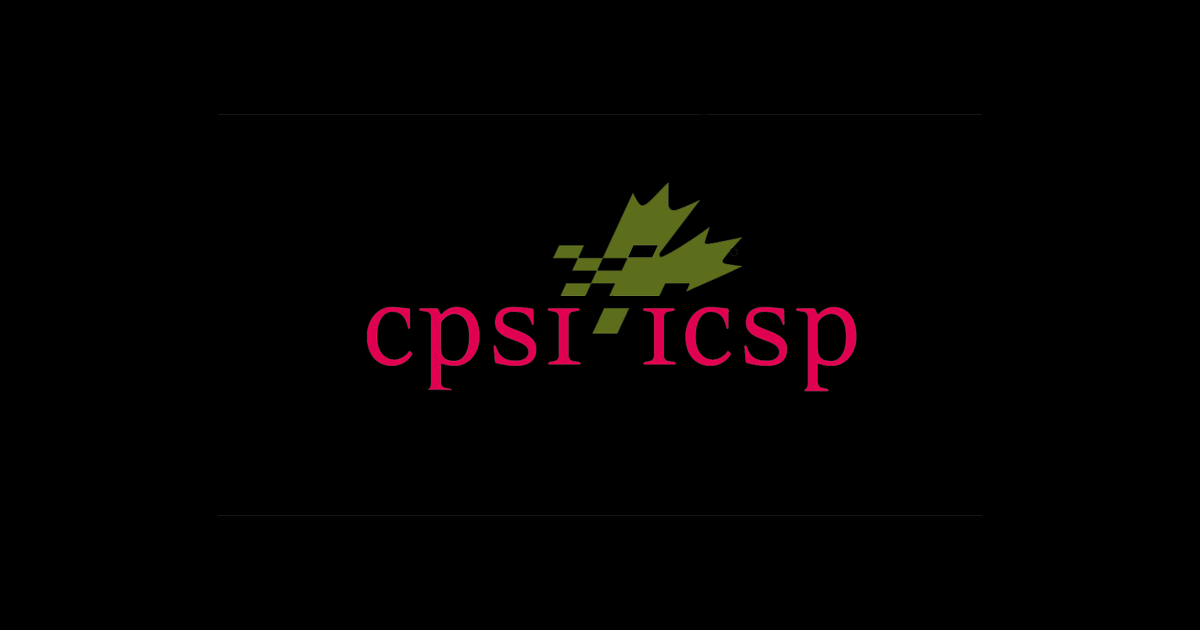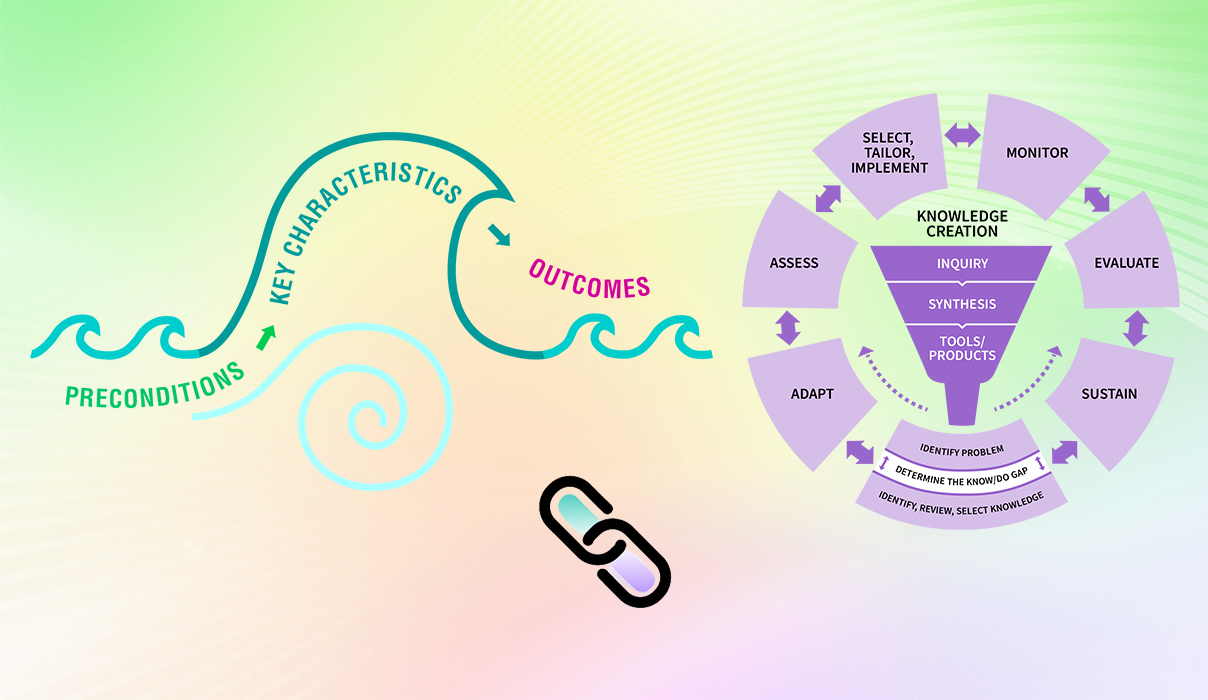Change is scaled up, scaled out or scaled deep
Index

What is this element?
A social movement can achieve and sustain change when planning, momentum and energy are present. Social movements for evidence-informed practices can then be spread to widen their impact, access and influence, and to maximize implementation efforts and health outcomes. This spread can occur on a continuum of scaling up or scaling out activities.
Scaling up involves expanding coverage and uptake for a change initiative. The change initiative is delivered in the same way, but to a different population or in a different setting. For example, a change initiative designed for one setting such as a public mental health clinic can be scaled up – or rolled out to other public mental health clinics across the province. Policymakers and change teams assume that outcomes will are similar across newer sites as long as the change is rolled out in the same way as at the original site.
To scale up and support wide dissemination, the goals and vision of the social movement must be framed to the context and understood by change agents and others. Scaled-up programs using social movement actions can be readily found in the public health sector and other sectors – for example initiatives targeting heart health promotion, childhood obesity prevention and workplace safety
SOURCES: Edwards, 2010; Grinspun, 2018a.
Scaling out is an extension of scaling up to standardize the change. Through scaling out, the spread of a change initiative such as an evidence-based program is further widened to broaden its delivery and impact. That is, the change is delivered to new populations altogether or through new delivery systems.
Example: When an acute care center scales out in-person smoking cessation groups to adults, here are some examples of possible scaling-out activities:
- a new delivery system could be used with the same population – virtual care for adults
- the same delivery system is used with a new population – in-person groups for seniors
- a new delivery system is used with a new population – virtual groups for seniors
A change can also be scaled deep, resulting in transformed values and norms.
When change is scaled deep, it transforms how individuals, groups and organizations think about the concerns or issues and creates lasting cultural shifts that become widely accepted, sustained and standardized.
To scale deep, the change must be deeply rooted in people and their relationships, communities and cultures. Scaling deep can occur at the micro level (for example, at the point-of-care), at the meso level (for example, within one or more settings or across an organization), and at the macro level (for example, in health systems in which they are transformed, often as the result of applying evidence, strategic advocacy and healthy public policy initiatives).
SOURCES: Aarons et al., 2017; Grinspun, 2018; Grinspun et al., 2018a; Moore et al., 2015.
Why is this element important?
- Scaling up, out or deep may lead to a new iteration or wave of a social movement, triggering renewed action. This new iteration could be shaped by:
- successes and challenges of the previous social movement
- periods of collective action and renewed interest by former or new change agents.
- When a change gets integrated into the fabric of the organization, it gets transformed and becomes scaled deep as the new norm. This can spark another wave of the social movement or catalyze a new movement (del Castillo et al., 2016; Grinspun et al., 2018a).
Case studies

Scaling up, scaling out and scaling deep a fall prevention initiative
RNAO’s Best Practice Spotlight Organization® (BPSO®) program itself was scaled up, scaled out and scaled deep – on the national level – when RNAO and the Canadian Patient Safety Institute (CPSI) entered into a formal partnership on a pan-Canadian falls prevention initiative campaign in 2007, with a focus on long-term care (LTC) (McConnell et al., 2018).
This collaboration involved the implementation of best practices, capacity building at the micro and meso levels with individuals and organizations, and engagement with national partners. The work was informed by the first and second editions of RNAO’s best practice guideline (BPG) Prevention of Falls and Fall Injuries in the Older Adult and CPSI’s program Safer Healthcare Now! on falls prevention as a critical patient safety issue Reducing Falls and Injuries from Falls.
The National Collaborative on Falls Prevention in Long-Term Care, launched in 2008–2009, included staff from 32 LTC homes and an interprofessional expert panel. The goals of the collaborative:
- to reduce the rate of falls in older adults by educating and training staff and patients about fall prevention
- develop a forum for improvement teams
- participate in a methodology on quality improvement initiatives using the Model for Improvement (Langley et al., 2009).
The collaboration was highly successful – process indicators showed decreased rates of falls in the LTC homes following implementation. However, it was determined that more time and support would be needed to scale the fall prevention initiative out and deep to in order to embed and sustain the practice changes.
In 2010–2011, the collaborative expanded to a national campaign where the program was delivered virtually to more than 45 organizations from diverse health sectors using web-based technology. This enabled greater access to the program with impressive outcomes, and showed that technology could be used as a tool to scale the program up and out.
This was followed up by creation and delivery of a fall prevention learning series in 2011–2012 to strengthen the uptake and sustainability of best practices. The training integrated implementation science, change theory and quality improvement methodology. As with the other collaboration components, the outcomes of the learning series demonstrated improvements in practice changes and reductions in falls causing injury, and organizational policies to support and sustain the change. The continued use of evaluation to determine outcomes and impact as part of quality improvement and using ongoing audit and feedback demonstrated a change that was scaled deep.
The collaboration helped embed principles of social action movement by its focus on a credible and important shared concern – preventing falls – where urgent change was needed. Momentum was used to support the continued engagement of fall prevention champions across sectors. Networks were used to share resources and expand collaborations across communities.

Scaling up change to address hunger and food waste through The Campus Kitchens Project
The Campus Kitchens Project (CKP) is an example of a successful scaled-up change initiative. Founded in 2001 as a branch of a community kitchen initiative that targeted food insecurity in Washington, D.C., United States, this non-profit is the first and largest student-led social movement taking on the crisis of food waste and hunger in the United States (Larson et al., 2017). More than 30,000 students in 63 universities, colleges and high schools are now repurposing unwanted or surplus food to provide meals to people who have food insecurity.
Working in leadership teams, student leaders and volunteers on campuses receive education, training and coaching over a period of several months to help empower people, families and communities on topics including:
- food insecurity
- improving social and nutritional health by increasing food knowledge and helping others developing cooking skills
The Campus Kitchen Project also establishes community partnerships with existing local organizations that provide services and food to individuals already challenged with food insecurity, such as senior housing facilities, youth outreach groups and churches. Local leadership teams also partner with dining services that operate large foodservice kitchens and dining halls and engage student groups and faculty advisors.
Student teams carry out different functions. While some teams focus on improving the way that homeless shelters prepare and deliver meals, other teams host communal dinners, partner with senior centers, or improve transportation to improve access to food.
“Instead of more branch offices or trying to provide all the services in-house, we find universities and students to partner with who already have the necessary resources on campus and want to do this kind of community impact work. Turning our nation’s institutions of higher education into hubs for replication and ongoing innovation could be the superhighway to scaling up for any nonprofit.” - Laura Toscano, Director, The Campus Kitchens Project
Considerations for getting started
Here are some strategies you and your change team can consider when scaling up, scaling out, or scaling deep:
|
Type of Scaling |
Scaling Strategies |
|
Scaling up |
|
|
Scaling out |
|
|
Scaling deep |
|
|
Any scaling up, scaling out, and/or scaling deep |
|
SOURCES: Aarons et al., 2017; Grinspun, 2018; Grinspun et al., 2018a; Moore et al., 2015; Sustainable Improvement Team and the Horizons Team, 2018.
A change is more likely to be scaled when it:
- demonstrates a clear advantage to current practice in ways that are meaningful to staff
- is seen as a rational decision and one that connects with staff’s hearts and minds, engaging emotions and values
- addresses a problem that is considered significant or as an important opportunity
- fits within the local context and the current system of care
- can be piloted before committing fully to the change
- engages change agents and others from the start so that they can co-design the change
- allows for opportunities to learn together
- is championed by formal leaders, including senior management teams
- includes all of the “CORRECT” attributes for scaling a change initiative (credible, observable, relevant, relative advantage, easy to use and understand, compatible, and testable)
- is supported by networks and communities granting access to the knowledge, skills and resources needed for the change
SOURCES: Grinspun et al., 2018a; McConnell et al., 2018; Rogers, 2003; Sustainable Improvement Team and the Horizons Team, 2018; World health Organization, 2010.
Implementation tools
Learn more details about the "CORRECT" attributes for scaling a change.
Check your progress
Use the list below to support change teams’ progress with scaling up a change initiative.
- Develop a roadmap. Determine where in which order and when the change will be scaled up. This will likely be influenced by change agents’ and groups’ perceptions of readiness, degree of collective identity, available budget and timelines. Use data to determine priority areas and sites most likely to succeed.
- Set up change agents for success. Make sure change agents have all the information, tools, templates and other resources needed to lead the scaled change. Assign a contact person or mentor for any questions, feedback or concerns.
- Be patient. Provide staff and others new to the change with clear steps of what is required. Be patient and remember that scaling takes time and careful planning. And, the time you invest in supporting new adopters is time well spent.
- Have a support system available to all adopters. Everyone involved in scaling needs a support system. Communication materials can be used to support standardized messaging. This can include written information, tools and templates for documentation and data collection, and tips and lessons learned from other sites where the change has been implemented.
- Continue to monitor and evaluate. It is important to continue to monitor and evaluate the impact of the innovation following scaling as added or new benefits may be determined in new sites. New challenges may also be identified through monitoring and evaluation.
- Establish shared infrastructure and platforms, where applicable. In cases where sites are accessing shared or similar information, it can be helpful to have shared infrastructure or platforms. Using these can reduce costs and improve consistent implementation practices.
- Grow the network of change agents. Channels such as a community of practice can act as a network for change agents and help them to access the support, enthusiasm, insights and lessons learned of others. Networks can also support the engagement of everyone involved in the scaled initiative.
- Seek to be consistent and flexible with the scaled change. Consistency is needed with scaling to recreate the benefits of the change. At the same time, some adaptation to the local context is essential to allow change agents to make the change their own and to maximize successes.
Accelerate Your Success: The Knowledge-to-Action Framework’s Sustain knowledge use” action cycle phase describes strategies for sustainment. To be able to scale change an innovation must be shown to be effective and sustainable. For change agents, developing capacity in sustainability can support the scaling of change to widen influence. Visit “Sustain knowledge use” to learn more strategies about sustainment and factors that hinder and help it.
Linking this outcome to other framework components

Linking this outcome to other elements of the Social Movement Action Framework:
Each of the elements of the Social Movement Action (SMA) Framework is dynamic and interrelated. For example, scaling change reflects the focus of the individual and collective action, and impacts whether the goal is to scale up or spread the change, scale out or change the standards, or scale deep to create new norms and culture. (Grinspun, 2018; Grinspun et al., 2018a; McConnell et al, 2018).
Momentum is critical – achievements related to scaling change typically require time and ongoing involvement in the social movement. A strong collective identity often inspires the speed and depth of change leveraging on an engaged network that shares support and resources (Serna Restrepo et al., 2018). And, throughout the change period, emerging leadership is needed with guidance from a core leadership structure such as a change team.
Linking this outcome to the action cycle phases of the Knowledge-to-Action Framework:
The capacity of you and your change team in social movement actions may be enhanced or accelerated by adding in some of the action cycle phases of the Knowledge-to-Action (KTA) Framework, as the two frameworks are complementary. In addition to the linkages example shared above, there can be many other points of connection between the two frameworks. Below are three examples for you to consider:
- Adapt knowledge to local context: Whether your change is scaled up, scaled out, or scaled deep depends on:
- the context and setting to which the change is being applied
- the individuals and groups that can be engaged to influence the change and ensure its success, and be influenced by it
- the resources needed to scale your change.
- Select, tailor and implement interventions: Sometimes, it is necessary to tailor the change to the local setting and needs to which the change is being applied. For example, a small tweak to an intervention may be needed to accommodate limited resources or infrastructure in a local setting may be needed. However, the intervention can still be scaled up, scaled out, or scaled deep as long as the intervention still keeps its core features and functions. This phase of the KTA action cycle can help you and your change team decide which parts of the intervention you can modify, and how you can do so.
- Sustain knowledge use: Change can be scaled up, scaled out, or scaled deep – but care must also be taken to maintain it. Your invested resources and efforts may be wasted if your change is not sustained, no matter how widely and how much it spreads across other organizations or communities. This KTA action cycle phase shares approaches and strategies you can use to ensure that your change is here to stay for the long term.
For more discussion about the dynamic links between the elements of the SMA Framework to one another and to the KTA Framework, see the section "Two complementary frameworks".


